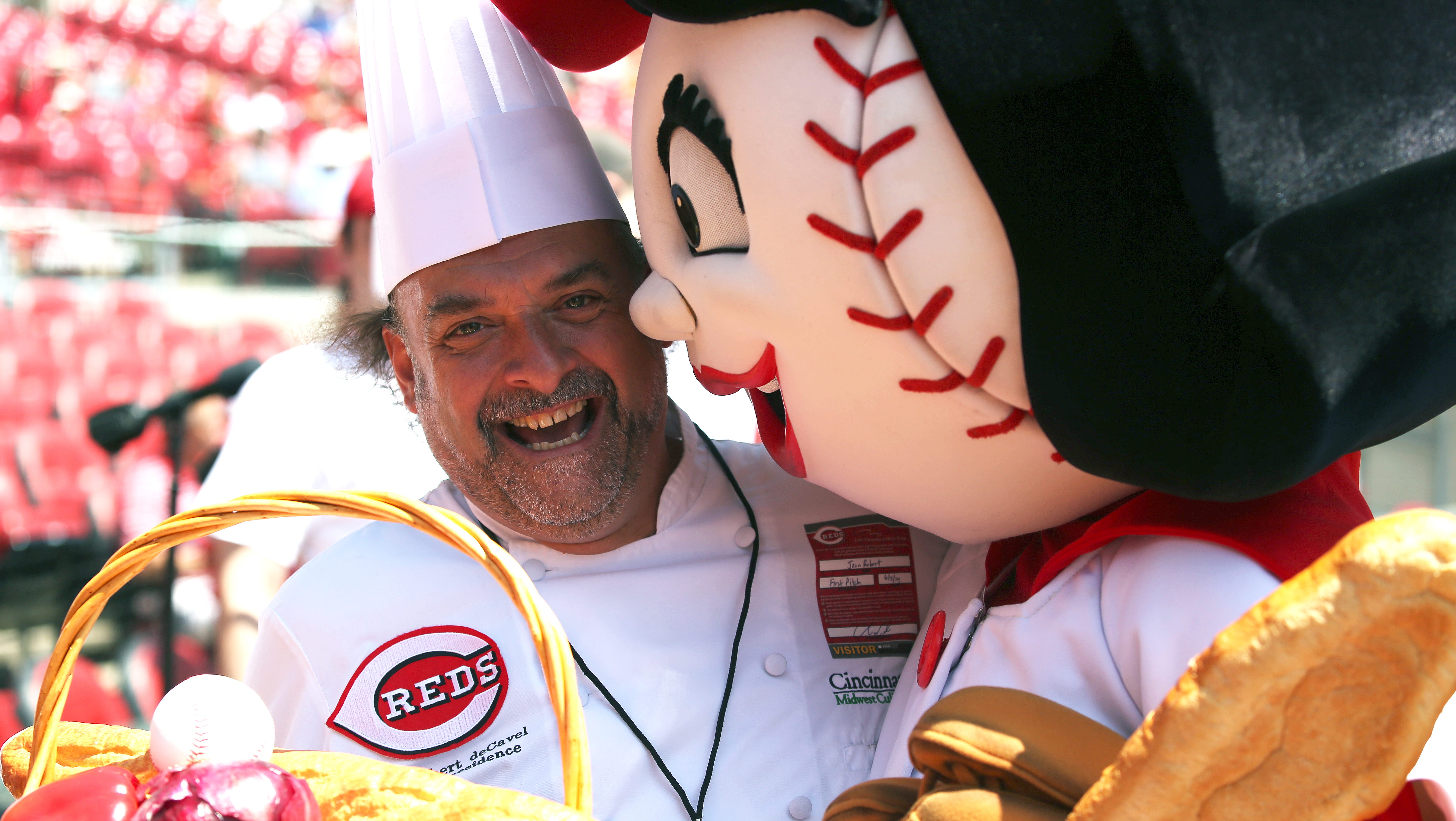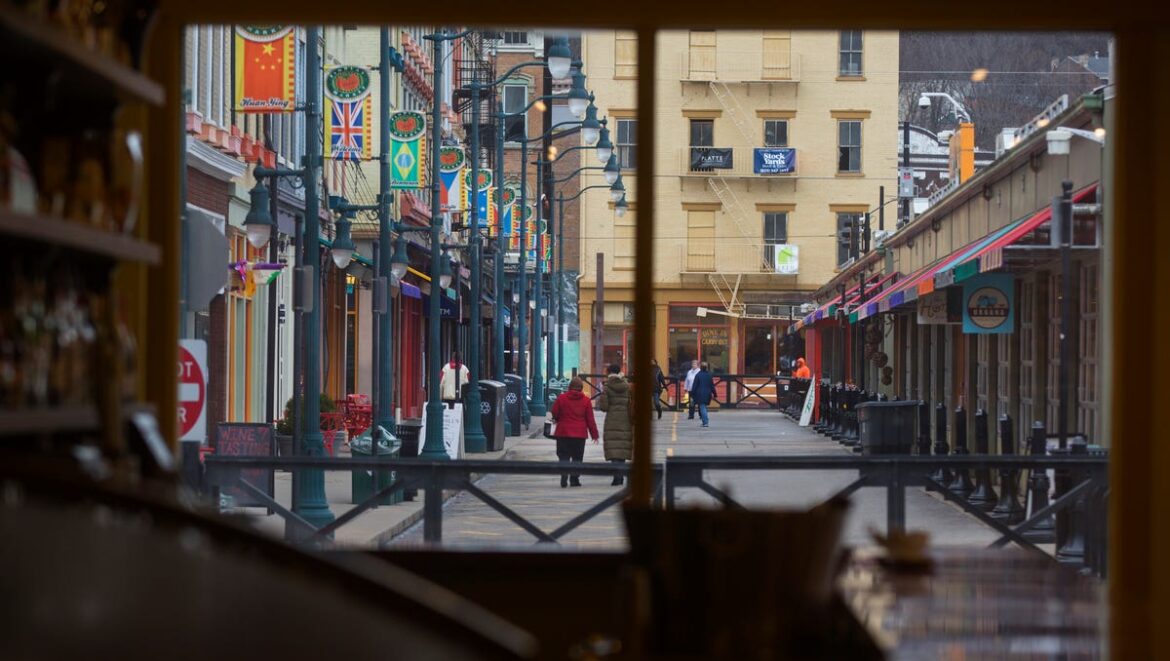
Jean-Robert prepares for 2014 Reds first pitch by throwing tomatoes
Jean-Robert de Cavel practices throwing out the first pitch for the Cincinnati Reds game, in honor of his 20 years in the city, by tossing tomatoes on behalf of The Enquirer in the alley behind his restaurant.
The Enquirer/Gary Landers
The recent closure of French Crust leaves just one Jean-Robert de Cavel restaurant open.It is just the most recent blow to Cincinnati’s legacy of French dining.Other chefs, including Danny Combs (of Colette) and David Falk (of Boca), hope to keep that legacy alive.
I remember sitting at the bar at French Crust Bistro a year or so after its founder, Jean-Robert de Cavel, died at the age of 61. While the city’s most famous and influential chef was gone, there was something about tucking into my braised beef tips and Robuchon potatoes that made me feel like he was sitting right beside me. “At least I still have this,” I thought, as I washed my meal down with a glass of Beaujolais.
French Crust’s location at Findlay Market was casual enough to pop in for lunch or breakfast without much fanfare. On a cold, wintry day, it felt heartwarmingly welcoming, and you could easily trick yourself into thinking you were in a Parisian cafe thanks to the ample windows with views of the market across the street and the French posters and trinkets that must have reminded de Cavel of his hometown of Roubaix, France.
“He always loved being across from Findlay Market,” Alana Askew, French Crust’s former chef de cuisine, told me in 2023. “It kept him connected to the community.”
Last week’s news of French Crust’s permanent closure was a blow to our city’s restaurant scene and de Cavel’s legacy. It also signaled yet another loss of a fading style of French dining that, for decades, defined Cincinnati’s place in the culinary universe.
A simple Google search will tell you that, in a city that once prided itself on having some of the best French restaurants in America, there are now only a handful of them left. Along with the loss of these restaurants, we’ve also lost something bigger: the spirit of French dining encouraged by de Cavel – one that focused on the mindful enjoyment of food, whether it was a plate of seafood vol-au-vent or a French chateau burger. Another glass of good wine? Oui! Would you like dessert? Oui oui! French dining allowed us to celebrate our collective sense of joie de vivre right here in Cincinnati.
“Our French history has always been strong having been called ‘the Paris of the Midwest’ for so many years,” Donna Covrett, who covered local dining for two decades as a food critic for Cincinnati Magazine, told me. “French barrel ice cream began here. We had the Gourmet Room and Pigall’s and Maisonette. But things change.”
A long history of French cuisine
Our obsession with French food may have started with Edith Fossett, an enslaved cook for Thomas Jefferson, who is credited with bringing French techniques to Cincinnati’s catering community in the mid-19th century.
According to The Enquirer’s Jeff Suess, “Fossett was 15 years old in 1802 when Jefferson chose her to join him at the White House – then known as the President’s House – to be trained as a cook under French chef Honoré Julien. After she was freed, she moved to Cincinnati in 1850, where her sons, Peter and William Fossett, used their mother’s recipes and cooking knowledge to create a successful catering business.”
Flash forward to 1948 when the Gourmet Room, a toney penthouse restaurant perched high above the city in the Terrace Plaza Hotel, opened. Not only was the restaurant notable for its surrealist painting by Joan Miro decorating the back wall, what really drew customers was its fantastic menu of coq au vin, lobster bisque and souffle Grand Marnier.
A year later came Maisonette, the famous restaurant opened by Nathan Comisar, a Russian immigrant who named his new spot, then located on Walnut Street, after a nightclub in New York City’s St. Regis Hotel. After Nathan’s death, the Comisar family relocated the restaurant to its iconic Sixth Street location in 1966.
In her book, “Cincinnati Food: A History of Queen City Cuisine,” former Enquirer food critic Polly Campbell mentions a quote from former Gourmet Room chef John Kinsella saying each restaurant presented a different version of the French dining experience. “The Maisonette was haute cuisine, the Gourmet Room was Parisian-style and Pigall’s was provincial,” he told Campbell.
Those three restaurants would eventually catapult Cincinnati to fame in the early 1970s when all three earned five-star ratings from the esteemed Mobil Travel Guide. Not only was it a point of civic pride, but it was also a reminder that this little river town knew how to punch above its weight.
Sadly, the Gourmet Room closed in 1992 and Maisonette shuttered in 2005. While Pigall’s closed in 1990, it reopened in 2004 with de Cavel at the helm, though his tenure lasted just five years, and the restaurant closed for good in 2009.
The next generation
After Pigall’s closed, many feared de Cavel would return to New York or France, leaving Cincinnati without a world-class French chef. Instead, he doubled down on the city. If Cincinnati was no longer a hot spot for French cuisine, he would at least make sure it was one where diners wouldn’t be deprived of it.
In the next decade, de Cavel would go on to open JeanRo Bistro, Pho Paris, Greenup Cafe, Twist and Lavomatic Cafe as well as French Crust, Le Bar a Boeuf and Frenchie Fresh.
These restaurants were in line with what was going on nationally as white tablecloths and valet service gave way to farm-to-table menus served in casual atmospheres – which started drawing a new generation of diners who were morel likely to don T-shirts and jeans than pressed pants and sport coats to dinner. While de Cavel made a brief return to fine French dining with Restaurant L, in 2016, its flame was prematurely extinguished with the arrival of the pandemic in 2020.
With the loss of French Crust, Le Bar le Boeuf, in East Walnut Hills, is the only de Cavel restaurant that remains open. Along with Colette Over-the-Rhine and Luca Bistro in Mount Adams, it is also one of the few remaining French-focused restaurants in town.
With its menu of Pâté de Maison and Poulet Frit à la Moutarde, Covrett said Colette, which is owned by former Sotto chef Danny Combs, has taken on the mantel of French cuisine in Cincinnati.
Speaking with Combs about his plans for Colette back in 2024, he told me that he didn’t think of his restaurant as a direct descendent of a de Cavel-style restaurant, but a nod to his profound influence on Cincinnati cuisine.
“Looking back on the history of French food in this city, I think there is a sense that it needs to be kept alive,” Combs told me. “The amazing work Jean-Robert did and the love this city had for him isn’t going anywhere. We hope to honor his legacy and push forward. He introduced so many chefs to French food. For us, it’s about keeping that alive.”
Carrying the flame
There is, perhaps, no one in Greater Cincinnati as invested in continuing de Cavel’s French dining than David Falk, who worked under de Cavel at Maisonette and, like his mentor, helped train some of the city’s finest chefs.
Not only did Falk take over the former Maisonette spot with his fine-dining restaurant, Boca, he is also among the few Greater Cincinnati chefs who still uses the French brigade system that he learned under de Cavel.
When I asked Falk about his feeling about the closure of French Crust and the decline of French cuisine in general, it led to an hour-long phone conversation during which he both agreed with my sentiment and shared some pretty big news that should comfort those who are worried that Cincinnati’s French dining scene is long gone.
According to Falk, he is currently working on a new French restaurant that he plans to open, according to him, “in the near future.”
While he shied away from offering any more details, Falk did say that he is fully committed to the project, adding that his goal is not only to keep French dining alive in Cincinnati, but for it to help define the city again. “Absolutely nobody is more committed and passionate about preserving French dining in this city than me,” Falk said.
So maybe Cincinnati’s days as French dining destination aren’t over yet. Maybe they’re just getting started.
Stay tuned.


Dining and Cooking